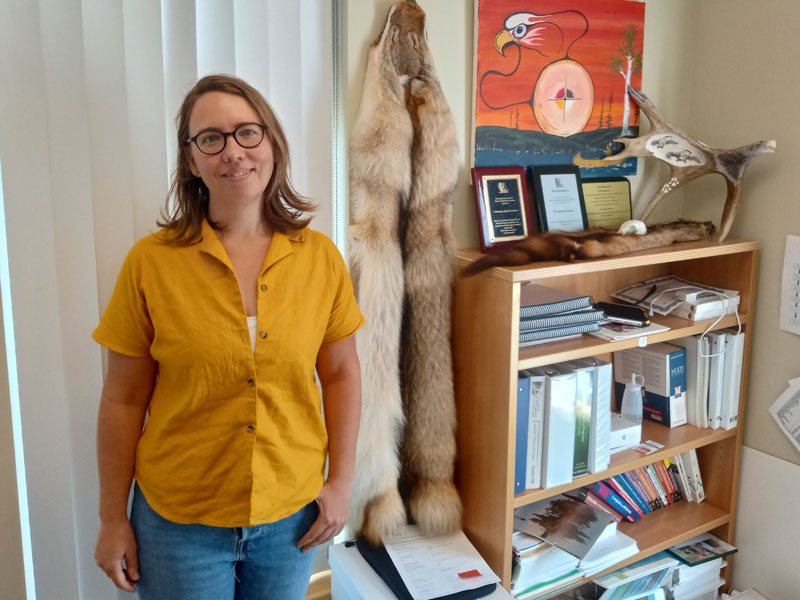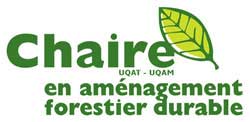
Annie Claude est récipiendaire du cône d'OR remis à la meilleure présentation étudiante en 2010 ainsi que pour la meilleure affiche (2016) remis dans le cadre du colloque annuel de la Chaire AFD.
Autres sites à consulter :
InstagramProjet de recherche : Allier modélisation forestière et savoirs autochtones pour évaluer la durabilité des paysages boréaux en transformation
Annie Claude Bélisle, Chrystal Mantyka-Pringle, Yan Boulanger, Benoit Crôteau, Alice Wapachee, Louis-Joseph Drapeau, Mélanie Desrochers, Hugo Asselin. Indigenous knowledge, forest landscape modeling, and the cumulative effects of environmental changes 2025. Ecological applications e70053
DOI : https://doi.org/10.1002/eap.70053
Yan Boulanger, Dominique Arseneault, Annie Claude Bélisle, Yves Bergeron, Jonathan Boucher, Yan Boucher, Victor Danneyrolles, Sandy Erni, Philippe Gachon, Martin P. Girardin, Éliane Grant, Pierre Grondin, Jean-Pierre Jetté, Guillemette Labadie, Mathieu Leblond, Alain Leduc, Jesus Pascual Puigdevall, Martin-Hugues St-Laurent, Junior A. Tremblay, Kaysandra Waldron. The 2023 wildfire season in Québec: an overview of extreme conditions, impacts, lessons learned, and considerations for the future 2024. Can. J. For. Res. 1-23
DOI : 10.1139/cjfr-2023-0298
Annie Claude Bélisle. L’histoire d’une découverte scientifique à Pikogan 2024. Le Couvert Boréal p. 27
Yan Boulanger, Dominique Arseneault, Annie Claude Bélisle, Yves Bergeron, Jonathan Boucher, Yan Boucher, Victor Danneyrolles, Sandy Erni, Philippe Gachon, Martin P. Girardin, Éliane Grant, Pierre Grondin, Jean-Pierre Jetté, Guillemette Labadie, Mathieu Leblond, Alain Leduc, Jesus Pascual Puigdevall, Martin-Hugues St-Laurent, Junior A. Tremblay, Kaysandra Waldron. La saison des feux de forêt 2023 au Québec : un aperçu des conditions extrêmes, des impacts, des leçons apprises et des considérations pour l’avenir 2024. Can. J. For. Res. 1-23
DOI : 10.1139/cjfr-2024-0230
Sylvie Gauthier, Timo Kuuluvainen, Ellen E. MacDonald, Ekaterina Shorohova, Anatoly Shvidenko, Annie Claude Bélisle, Marie-André Vaillancourt, Alain Leduc, Guillaume Grosbois, Yves Bergeron, Hubert Morin, Miguel Montoro Girona. Ecosystem Management of the Boreal Forest in the Era of Global Change 2023. In: Girona, M.M., Morin, H., Gauthier, S., Bergeron, Y. (eds) Boreal Forests in the Face of Climate Change. Advances in Global Change Research, vol 74. Springer, Cham. 3
DOI : 10.1007/978-3-031-15988-6_1
no result
Yan Boulanger, Jesus Pascual Puigdevall, Annie Claude Bélisle, Yves Bergeron, Marie-Hélène Brice, Louis De Grandpré, Daniel Fortin, Sylvie Gauthier, Pierre Grondin, Guillemette Labadie, Mathieu Leblond, Maryse Marchand, Tadeusz B. Splawinski, Martin-Hugues St-Laurent, Évelyne Thiffault, Junior A. Tremblay, Dominic Cyr, Stephen H. Yamasaki, . A regional integrated assessment of the impacts of climate change and of the potential adaptation avenues for Quebec’s forests. 2023. Can. J. For. Res. 53(8):556-578
DOI : 10.1139/cjfr-2022-0282
Yan Boulanger, Jesus Pascual Puigdevall, Annie Claude Bélisle, Yves Bergeron, Marie-Hélène Brice, Dominic Cyr, Louis De Grandpré, Daniel Fortin, Sylvie Gauthier, Pierre Grondin, Guillemette Labadie, Mathieu Leblond, Maryse Marchand, Tadeusz Bartek Splawinski, Martin-Hugues St-Laurent, Évelyne Thiffault, Junior Tremblay, Stephen Yamasaki. A regional integrated assessment of the impacts of climate change and of the potential adaptation avenues for Quebec’s forests. 2023. Can. J. For. Res.
DOI : 10.1139/cjfr-2022-0282
Annie Claude Bélisle, Sylvie Gauthier, Hugo Asselin. Integrating Indigenous and scientific perspectives on environmental changes: Insights from boreal landscapes. 2022. People and Nature 4(6):1513-1535
DOI : 10.1002/pan3.10399
Annie Claude Bélisle. Effets cumulatifs des changements environnementaux sur la valeur des paysages autochtones en zone boréale. 2022. Thèse de doctorat en sciences de l'Environnement, Université du Québec en Abitibi-Témiscamingue. 344 p.
Hugo Asselin, Annie Claude Bélisle. A collaborative typology of boreal Indigenous landscapes. 2021. Can. J. For. Res. 51(9):1253-1262
DOI : 10.1139/cjfr-2020-0369
Annie Claude Bélisle Développement du dialogue entre les perspectives des Abitibiwinnik et de la recherche scientifique sur le territoire Colloques du SCF-CFL (2025-02-06) youtube
Pierre Drapeau, Osvaldo Valeria, Sonia Légaré, Annie Claude Bélisle. La collaboration Université - Industrie - Gouvernement - Communauté en science forestière et écologique : pourquoi et comment ? Atelier colloque Chaire AFD (2023-11-28)
Annie Claude Bélisle Conseil de la Première Nation Abitibiwinni (Pikogan) 25e colloque de la Chaire AFD. Université du Québec en Abitibi-Témiscamingue, Rouyn-Noranda, Québec. (2023-11-28)
Yan Boulanger, Annie Claude Bélisle, Yves Bergeron, Marie-Hélène Brice, Dominic Cyr. Impacts des changements climatiques sur les forêts québécoises : ce qu'une analyse intégrée régionale nous a appris 15e colloque annuel du CEF, Université de Sherbrooke, Québec (2022-09-29)
Annie Claude Bélisle Effets cumulatifs des changements environnementaux sur la valeur des paysages autochtones en zone boréale Soutenance thèse (2021-11-16)
Annie Claude Bélisle Allier modélisation forestière et savoirs autochtones pour évaluer la durabilité des paysages boréaux en transformation. Colloques du SCF-CFL (2021-02-10)
Annie Claude Bélisle, Hugo Asselin. Allier modélisation et savoirs autochtones. Série de webinaires sur l'analyse intégrée régionale des impacts des changements climatiques sur la forêt du Québec organisée par le Service canadien des forêts (2021-02-10)
Annie Claude Bélisle, Hugo Asselin. Affiche 16
État de l’environnement des terrains de trappe des
communautés autochtones de Pikogan et d’OujéBougoumou 20e colloque de la Chaire AFD. Université du Québec en Abitibi-Témiscamingue, Lorrainville, Québec. (2018-11-30)
Annie Claude Bélisle, Hugo Asselin. Adaptation du cadre des services écosystémiques au contexte autochtone 19e colloque de la Chaire AFD. Université du Québec en Abitibi-Témiscamingue, Ste-Germaine-Boulé, Québec. (2017-11-30)
Annie Claude Bélisle Intégration des savoirs locaux en écologie 18e colloque de la Chaire AFD. Université du Québec en Abitibi-Témiscamingue, Rouyn-Noranda, Québec. (2016-12-01)
Laura Marcela Fuentes Serna, Maël Casu, Annie Claude Bélisle, Hugo Asselin. Résilience des communautés des Premières Nations aux impacts cumulatifs de l'exploitation des ressources naturelles et des changements climatiques dans le Québec boréal 18e colloque de la Chaire AFD. Université du Québec en Abitibi-Témiscamingue, Rouyn-Noranda, Québec. (2016-12-01)
Annie Claude Bélisle, Hugo Asselin. Résilience de la forêt boréale à l'exploitation des ressources naturelles et aux changements climatiques : impacts sur la valeur du territoire autochtone 18e colloque de la Chaire AFD. Université du Québec en Abitibi-Témiscamingue, Rouyn-Noranda, Québec. (2016-12-01)
Annie Claude Bélisle Impacts cumulatifs des changements climatiques et de l'exploitation des ressources naturelles sur la résilience de la forêt boréale, une perspective autochtone. projet thèse (2015-09-23)
Annie Claude Bélisle L’historique des feux, un outil pour l’aménagement durable de la forêt au nord du Lac St-Jean 12e colloque de la Chaire AFD. Université du Québec en Abitibi-Témiscamingue, Rouyn-Noranda, Québec. (2010-11-13)
Annie Claude Bélisle Retracer l'historique des feux pour un aménagement durable de la forêt au nord du Lac St-Jean. Affiche scientifique 11e colloque de la Chaire AFD. Université du Québec en Abitibi-Témiscamingue, Rouyn-Noranda, Québec. (2009-12-09)
